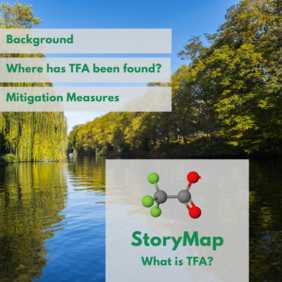Experts at TZW have developed a StoryMap on the topic of trifluoroacetate (TFA), that provides an easy-to-understand introduction to the complex topic and briefly summarises the current TFA situation in Germany. In addition, an interactive TFA map was created based on data from monitoring programmes of 13 federal states and several water supply companies. The map facilitates an overview of the sources and contamination by the environmental chemical TFA by activating individual layers and focusing on specific regions.
The map and the StoryMap show results of the project "Trifluoroacetate (TFA): Laying the foundations for effective mitigation – Spatial analysis of the input pathways into the water cycle", which was realised and recently completed by TZW: DVGW-Technologiezentrum Wasser (German Water Centre), Karlsruhe and IWW Water Centre on behalf of the Federal Environment Agency (UBA).
TFA is a degradation product of many different substances, including refrigerants and pesticides. Wastewater discharges from industrial plants that produce or use certain fluorochemicals sometimes cause high peak loads in flowing waters and can increase the TFA load downstream. In addition, a large number of pesticides containing TFA precursors cause widespread contamination of groundwater and surface water bodies. TFA is not degradable in the environment and accumulates in the water cycle. It is also highly mobile and can hardly be removed by technical means, even in drinking water treatment. Despite its toxicological inconspicuousness, TFA therefore poses a challenge for resource and general water protection.
The interactive map and the StoryMap provide a comprehensive picture of the situation of TFA in Germany - not only for experts. Take a look!
Link to StoryMap: Trifluoracetate (TFA) (arcgis.com)
Link to the interactive map (in English): Trifluoracetat (TFA) auf arcgis.com
Further in-depth project results and an explanation of the methodology can be found in the final report, which will additionally be published in English soon: https://www.umweltbundesamt.de/publikationen/trifluoracetat-tfa-grundlagen-fuer-eine-effektive.

![[Translate to English:] Prüfstelle-Produktprüfung_Teststand Test centre and product testing](/fileadmin/_processed_/0/9/csm_TZW-Karlsruhe_Pruefung_Geraete-Teststand_377188946c.jpg)

























